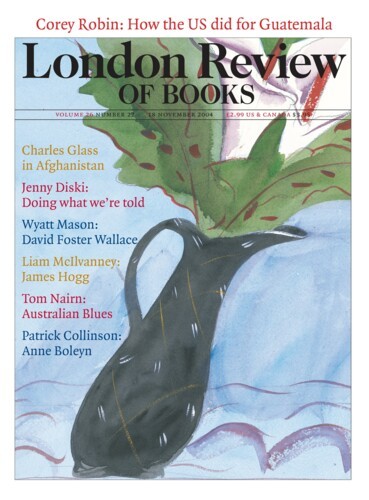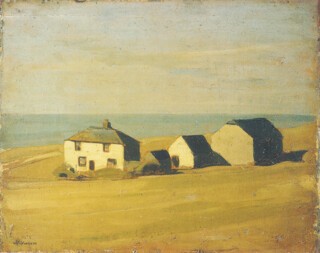William Nicholson painted in white ducks and patent leather shoes. In photographs and caricatures his neat head sits on high white collars. He liked spotted shirts and fancy waistcoats. He was fun to be with but unrevealing about his art. His paintings and woodcuts give great pleasure; but no telling clumsiness draws us in: no impossible anatomy of the kind that makes Cézanne a challenge, none of the raw excitement of Expressionism, none of his son Ben’s abstract chill.
The desire to make pictures, the desire to look at them and the desire to own them are distinct and not always compatible. But William Nicholson’s small oil paintings of landscapes, jugs, bowls, silver boxes, glass, pottery, flowers, boots, gloves and food bring those desires to a single focus. He must have liked making them. The evidence is in the brush marks. The ability to judge a tone and to put down an area of colour which is its equivalent brings painting near to sport. When he hits off the play of light through cloud on a Welsh hillside the strokes are as simple in their effect, and as hard to imitate, as the stroke that hits a ball squarely and directs it just where you want it to go, and the moment probably as pleasurable. For him, as for Manet, Sargent, Whistler and other near contemporaries, Velázquez was the master.
What must have made Nicholson’s small oils enjoyable to paint explains a good part of what makes them a pleasure to look at, but although the cake, mugs and teapot are pleasing enough in themselves, his china cupids and figurines wouldn’t make me pause at a junk shop window. The pleasure is in the way highlights explain shapes and in the way the objects participate in little puzzles about scale and reflection.
The pictures invite interrogation – you ask how they come to create an illusion and why just those colours and shapes should be physically attractive – but they don’t challenge you. And they are small. No wonder they sold quickly, and that so many, it would seem from the provenances in the catalogue of the show at the Royal Academy (until 23 January),* are still in private hands. If you inherited one you would want to hold onto it. They are more covetable than many stronger, larger, greater paintings.
These little pictures were not the only ones Nicholson made, and not everything he did was as nice to make, own and view. The portraits, which, to the extent that they were commissions, must have been desired, are only sometimes a pleasure to look at. And one knows from his complaints, or guesses from the inordinate time they took to complete, that some were no fun at all to do, even if they did provide most of his income for most of his life (and earn him a knighthood).
The portraits, too, judging by those in the exhibition, invite attention rather than grab it. The 1903 full-length portrait of Max Beerbohm, his eyes cast down, offers no glance for the viewer to catch; the Breton Girl (1907) and Marie (1910) turn from you, even their profiles half lost; the face of Sybil Hart-Davis lying on a bed (she was, the catalogue tells us, an ‘acknowledged beauty’ who was undergoing a rest cure) is so tiny a part of a small picture (about two and a half inches’ worth of a 30-inch canvas) that it is registered in half a dozen elegant smudges of paint; George Saintsbury and Gertrude Jekyll sit in patient, unanimated reverie. What we get is the person objectified rather than an expressed personality. The look in the eye, the self-presenting stance – the kind of thing Sargent looked for – is missing. Even Nicholson’s large group portrait of the Canadian Headquarters Staff – painted during or just after the war – reads as a scene happened upon. Three of the six figures are in profile and only one looks at you; they might be waiting outside an office for a meeting to begin. A gigantic sepia photograph of the gutted Cloth Hall in Ypres forms the background; red cap-bands are the only bright colours. It is an uncommonly fine piece of official portraiture, pleasing in its lack of eloquence.
The patterned woodcuts he made in the 1890s are now – have probably always been – Nicholson’s most familiar work. Some are based on photographs. They all simplify form in the way a ‘posterised’ photograph – one in which the middle tones are dropped out – does. They are usually minimally hand coloured. The outlines are strong and large areas of solid black contrast with equal areas of bare paper. What connects the two sets of images – the woodcuts and the paintings – is a kind of parsimony. In the woodcuts a dress or coat will be a silhouette within which folds and sleeves are implied, not shown. The painted landscapes of the Downs show only one or two hills, the still lifes often include only a single bowl of flowers, a single glass or a single jug. They are easy pictures to read, very little in them is redundant. In the painting of a City dinner, the faces are little more than pink blobs, differentiated just enough for you to see who is bald, who has a moustache, who wears glasses. But sometimes it takes a moment to get the point. In the landscapes you have to notice the tiny figures and animals to understand the scale. A talent for economy is one Nicholson shared with great illustrators; after all, he was one.
Ben Nicholson said of his father that ‘he merely wanted to paint.’ He belonged to no group and said nothing at all about his art. So how do you place him historically? In his biography of Nicholson, Sanford Schwartz tries to explain his absence from recent accounts of English painting: accounts which are, he reckons, a ‘maimed affair . . . especially as told in the numbingly honest, self-hating tones generally used for the job since the 1950s’.† The most illuminating of the angles he offers in his attempt to establish a place for Nicholson in the national school and international world are literary rather than visual. He was a friend or acquaintance of at least as many writers as artists; the former offer more interesting comparisons. He shared a dandified facetiousness with Beerbohm (who did caricatures of him), he wrote and illustrated books for children, as did Kipling (of whom Nicholson made a remarkable woodcut), he worked with J.M. Barrie (whose portrait he painted) on costumes and sets for the first production of Peter Pan. These were all men who, like Nicholson, had early successes. And like him they were popular, not difficult, middlebrow not highbrow. Kipling’s short stories may initially read like puzzles: he reduced his narratives to essentials in much in the same way as Nicholson reduced detail in his woodcuts. Awkward sincerity never gets in the way of the dandy’s desire to achieve an appearance of effortlessness, to write and paint with a directness in which economy of utterance goes with conversational ease rather than deep thought. So while it’s possible to find, as Schwartz does, artists working today to compare with Nicholson, his pleasure in doing the popular thing while keeping the viewer at a safe emotional distance, to hint at mysteries and ambiguities but not explore them, is so much of his own time that the connections are not profound.
Nicholson’s art of simplification led to landscapes in which the foreground is omitted: you tend to see a distant view – the figures, trees, bits of building and so forth that commonly frame landscapes are missing. The smooth humps of downland suited his purpose. Snow, another great simplifier, did too. He did paint a picture of 100 jugs, but his still lifes became simpler in content and arrangement over time. In The Lowestoft Bowl (1911) and the picture of a lustre bowl with green peas, the main items are off-centre, giving a diagonal thrust to the composition. Later, even that degree of compositional self-consciousness gives way to pictures in which single objects (a fish and lumps of ice on a plate, a pewter jug) sit in the middle of the canvas.
In these less-arranged still lifes, you feel the subject was not composed at all, but painted as found – in the form that it caught the painter’s eye. Most of these pictures of things are, like George Saintsbury in the portrait of 1923, seen from above (Degas did portraits from that angle, too). Compositions in which objects stand on a shelf at eye-level (Chardin, Caravaggio), and where the face of the sitter is seen at eye level (most formal portraits), are the rule in Western art up to the late 19th century. In that sense, Nicholson was a Modernist – but only as Degas or Manet were. The flavour of his particular version of things-as-seen is personal; its strength is only partly in the suavity of his transcriptional style. The high viewpoints, the framing of subjects and the ratio of figure to ground are all pleasingly odd. He paints a picture of the return of the Mona Lisa to the Louvre in which the distant picture and the crowd around it are the background and a dark figure looking towards you, to a painting beyond you, is the dominant subject. In Café de Paris (1914), two tiny heads-and-shoulders in profile appear above the frame of a huge mirror which reflects another mirror behind you. Most of the surface of the canvas depicts the vague recession of that double reflection. The portrait of Barrie sets the half-length figure, which takes up not much more than a quarter of the canvas, against a greyish wall. Nicholson invented, in a small way, a new way of looking within an old way of painting.
His relation with his son Ben was complicated. Although he paid him an allowance for many years, he was unimpressed with the art that allowance supported. When one looks back, one finds their work has more in common than one might have imagined. Both were fastidious workers in their chosen genres. Ben was more serious about art, its nature and future – he was a joiner and talker. It would be ironic if, looking for a secure place for William in the history of English painting, one wished on the dandy, the clever author of Clever Bill (one of the best and most amusing picture books for children ever made), a mantle of comparisons which obscured his different, but equally serious dedication to an art about which he said – and, I suspect, wished to say – nothing.
Send Letters To:
The Editor
London Review of Books,
28 Little Russell Street
London, WC1A 2HN
letters@lrb.co.uk
Please include name, address, and a telephone number.


